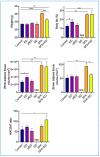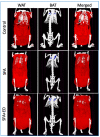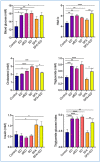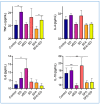Chronic Intake of Energy Drinks and Their Sugar Free Substitution Similarly Promotes Metabolic Syndrome
- PMID: 33917297
- PMCID: PMC8067378
- DOI: 10.3390/nu13041202
Chronic Intake of Energy Drinks and Their Sugar Free Substitution Similarly Promotes Metabolic Syndrome
Abstract
Energy drinks containing significant quantities of caffeine, taurine and sugar are increasingly consumed, particularly by adolescents and young adults. The putative effects of chronic ingestion of either standard energy drink, MotherTM (ED), or its sugar-free formulation (sfED) on metabolic syndrome were determined in wild-type C57BL/6J mice, in comparison to a soft drink, Coca-Cola (SD), a Western-styled diet enriched in saturated fatty acids (SFA), and a combination of SFA + ED. Following 13 weeks of intervention, mice treated with ED were hyperglycaemic and hypertriglyceridaemic, indicating higher triglyceride glucose index, which was similar to the mice maintained on SD. Surprisingly, the mice maintained on sfED also showed signs of insulin resistance with hyperglycaemia, hypertriglyceridaemia, and greater triglyceride glucose index, comparable to the ED group mice. In addition, the ED mice had greater adiposity primarily due to the increase in white adipose tissue, although the body weight was comparable to the control mice receiving only water. The mice maintained on SFA diet exhibited significantly greater weight gain, body fat, cholesterol and insulin, whilst blood glucose and triglyceride concentrations remained comparable to the control mice. Collectively, these data suggest that the consumption of both standard and sugar-free forms of energy drinks induces metabolic syndrome, particularly insulin resistance.
Keywords: artificial sweetener; blood glucose; body fat; brown adipose tissue; cholesterol; energy drinks; insulin; metabolic syndrome; triglycerides.
Conflict of interest statement
The authors declare no conflict of interest.
Figures





Similar articles
-
The Consumption of Energy Drinks Induces Blood-Brain Barrier Dysfunction in Wild-Type Mice.Front Nutr. 2021 May 3;8:668514. doi: 10.3389/fnut.2021.668514. eCollection 2021. Front Nutr. 2021. PMID: 34012975 Free PMC article.
-
The metabolic disorders associated with chronic consumption of soft and energy drinks in rats.Acta Biochim Pol. 2020 Mar 19;67(1):79-84. doi: 10.18388/abp.2020_2914. Acta Biochim Pol. 2020. PMID: 32191411
-
Metabolic and behavioural effects of sucrose and fructose/glucose drinks in the rat.Eur J Nutr. 2012 Jun;51(4):445-54. doi: 10.1007/s00394-011-0228-x. Epub 2011 Jul 29. Eur J Nutr. 2012. PMID: 21800086
-
Beverage consumption and paediatric NAFLD.Eat Weight Disord. 2016 Dec;21(4):581-588. doi: 10.1007/s40519-016-0315-3. Epub 2016 Aug 26. Eat Weight Disord. 2016. PMID: 27565159 Review.
-
Are Liquid Sugars Different from Solid Sugar in Their Ability to Cause Metabolic Syndrome?Obesity (Silver Spring). 2019 Jun;27(6):879-887. doi: 10.1002/oby.22472. Epub 2019 May 4. Obesity (Silver Spring). 2019. PMID: 31054268 Review.
Cited by
-
Machine learning analysis of emerging risk factors for early-onset hypertension in the Tlalpan 2020 cohort.Front Cardiovasc Med. 2025 Jan 17;11:1434418. doi: 10.3389/fcvm.2024.1434418. eCollection 2024. Front Cardiovasc Med. 2025. PMID: 39896047 Free PMC article.
-
Long-Term Consumption of a Sugar-Sweetened Soft Drink in Combination with a Western-Type Diet Is Associated with Morphological and Molecular Changes of Taste Markers Independent of Body Weight Development in Mice.Nutrients. 2022 Jan 29;14(3):594. doi: 10.3390/nu14030594. Nutrients. 2022. PMID: 35276952 Free PMC article.
-
The Beneficial Effects of Two Polysaccharide Fractions from Sargassum fusiform against Diabetes Mellitus Accompanied by Dyslipidemia in Rats and Their Underlying Mechanisms.Foods. 2022 May 13;11(10):1416. doi: 10.3390/foods11101416. Foods. 2022. PMID: 35626992 Free PMC article.
-
Pathophysiological Role of Neutrophil Extracellular Traps in Diet-Induced Obesity and Metabolic Syndrome in Animal Models.Nutrients. 2025 Jan 10;17(2):241. doi: 10.3390/nu17020241. Nutrients. 2025. PMID: 39861371 Free PMC article. Review.
-
The Effects of Chronic Consumption of Lipid-Rich and Delipidated Bovine Dairy Milk on Brown Adipose Tissue Volume in Wild-Type Mice.Nutrients. 2021 Nov 26;13(12):4266. doi: 10.3390/nu13124266. Nutrients. 2021. PMID: 34959820 Free PMC article.
References
-
- Grundy S.M., Cleeman J.I., Daniels S.R., Donato K.A., Eckel R.H., Franklin B.A., Gordon D.J., Krauss R.M., Savage P.J., Smith Jr S.C. Diagnosis and management of the metabolic syndrome: An American Heart Association/National Heart, Lung, and Blood Institute scientific statement. Circulation. 2005;112:2735–2752. doi: 10.1161/CIRCULATIONAHA.105.169404. - DOI - PubMed
MeSH terms
Substances
Grants and funding
LinkOut - more resources
Full Text Sources
Other Literature Sources
Medical

